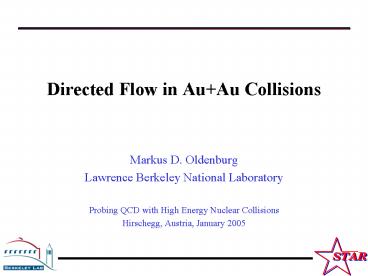Directed Flow in Au Au Collisions PowerPoint PPT Presentation
Title: Directed Flow in Au Au Collisions
1
Directed Flow in AuAu Collisions
- Markus D. Oldenburg
- Lawrence Berkeley National Laboratory
- Probing QCD with High Energy Nuclear Collisions
- Hirschegg, Austria, January 2005
2
Overview
- Introduction
- Model Predictions for Directed Flow
- Measurements Results
- Model comparisons to data
- Summary and Outlook
3
Anisotropic Flow
- spatial
- anisotropy
- momentum
- anisotropy
- sensitive to the EoS
- peripheral collisions produce an asymmetric
particle source in coordinate space
- Fourier decomposition of azimuthal particle
distribution in momentum space yields
coefficients of different order
- v1 directed flow
- v2 elliptic flow
4
Antiflow of nucleons and 3rd flow component
AuAu, EkinLab 8 A GeV
J. Brachmann, S. Soff, A. Dumitru, H. Stöcker, J.
A. Maruhn, W. Greiner, L. V. Bravina, D. H.
Rischke, PRC 61 (2000), 024909.
ltpxgt (GeV/c)
L. P. Csernai, D. Röhrich, PLB 45 (1999), 454.
y/ycm
- Softening of the EoS can occur due to a phase
transition to the QGP or due to resonances and
string like excitations. - At mid-rapidity, antiflow cancels bounce off.
- Models with purely hadronic EoS dont show this
effect.
- Bounce off nucleons at forward rapidity show
positive flow. - If matter is close to softest point of EoS, at
mid-rapidity the ellipsoid expands orthogonal to
the longitudinal flow direction.
QGP ? v1(y) flat at mid-rapidity.
5
Stopping and space-momentum correlation
RQMD v2.4 (cascade mode)
R. Snellings, H. Sorge, S. Voloshin, F. Wang, N.
Xu, PRL 84 (2000), 2803.
- collective expansion of the system implies
positive space-momentum correlation - wiggle structure of v1(y) develops
- shape of wiggle depends on centrality, system
size, and collision energy - even pion v1(y) shows a wiggle structure or
flatness at mid-rapidity
No QGP necessary ? v1(y) wiggle.
6
Directed flow (v1) at RHIC at 200 GeV
charged particles
- shows no sign of a wiggle or opposite slope at
mid-rapidity - Predicted magnitude of a wiggle couldnt be
excluded. - v1 signal at mid-rapidity is rather flat
J. Adams et al. (STAR collaboration), PRL 92
(2004), 062301.
7
Charged particle v1(?) at 62.4 GeV
- Three different methods
- v13
- v1EP1,EP2
- v1ZDCSMD
- Sign of v1 is determined with spectator neutrons.
- v1 at mid-rapidity is not flat, nor does it show
a wiggle structure
STAR preliminary
charged particles
8
Centrality dependence of v1(?) at 62.4 GeV
STAR preliminary
- Different centrality bins show similar behavior.
- Methods agree very well.
- Most peripheral bin shows largest flow.
charged particles
9
Centrality dependence of integrated v1
midrapidity
- integrated magnitude of v1 increases with impact
parameter b - The strong increase at forward rapidities (factor
3-4 going from central to peripheral collisions)
is not seen at mid-rapidities. - Note the different scale for mid-rapidity and
forward rapidity results!
charged particles
STAR preliminary
forward rapidity
10
Comparison of different beam energies
STAR preliminary
- Data shifted with respect to beam rapidity.
- good agreement at forward rapidities, which
supports limiting fragmentation in this region
charged particles
ydiff y200GeV y17.2,62.4GeV y200GeV
5.37 y62.4GeV 4.20
y17.2GeV 2.92
- NA49 data taken from
- C. Alt et al. (NA49 Collaboration), Phys. Rev.
C 68 (2003), 034903.
11
v1 data and simulations at 62.4 GeV
STAR preliminary
- All models reproduce the general features of v1
very well! - At high ? Geometry the only driving force?
- see Liu, Panitkin, Xu PRC 59 (1999), 348
- At mid-rapidity we see more signal than expected
by the models.
charged particles
12
RQMD simulations for 62.4 GeV I
- Hadron v1 is very flat at mid-rapidity.
- Pion v1 is very flat at mid-rapidity, too.
- (There is a very small positive slope around
?0.)
- Proton v1 shows a clear wiggle structure at
mid-rapidity. - The overall ( hadron) behavior of v1 gets more
and more dominated by protons when going forward
in pseudorapidity.
13
Summary I
- Directed flow v1 of charged particles at 62.4 GeV
was measured. - The mid-rapidity region does not show a flat
signal of v1. A finite and non-zero slope is
detected. - The centrality dependence of v1(?) shows a smooth
decrease in the signal going from peripheral to
central collisions. - At mid-rapidity theres no significant centrality
dependence of v1 observed, while at forward
rapidities directed flow increases 3-fold going
from central to peripheral collisions. - At forward rapidities our signal at 62.4 GeV
agrees with (shifted) measurements at 17.2 and
200 GeV.
14
Summary II
- Model predictions for the pseudorapidity
dependence of v1 agree very well with our data,
especially at forward rapidities. - The very good agreement between different models
indicates a purely geometric origin of the v1
signal. - RQMD simulations show a sizeable wiggle in
protons v1(?), only. - Measurements of identified particle v1 at
mid-rapidity will further constrain model
predictions. - High statistics measurement of v1 at 200 GeV to
come.
15
Directed flow v1 vs. transverse momentum pt
STAR preliminary
- magnitude of v1 increases with pt and then
saturates - Note the different scale for mid-rapidity and
forward rapidity results!
- pt-dependence of v1 still awaits explanation by
models!

